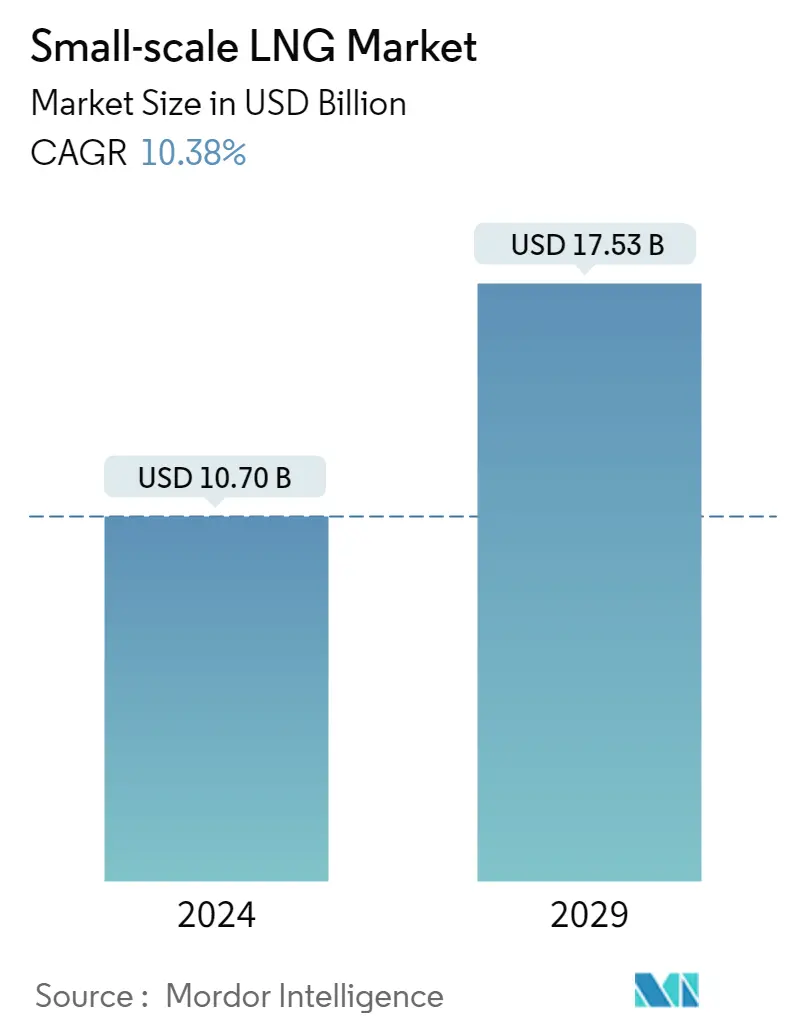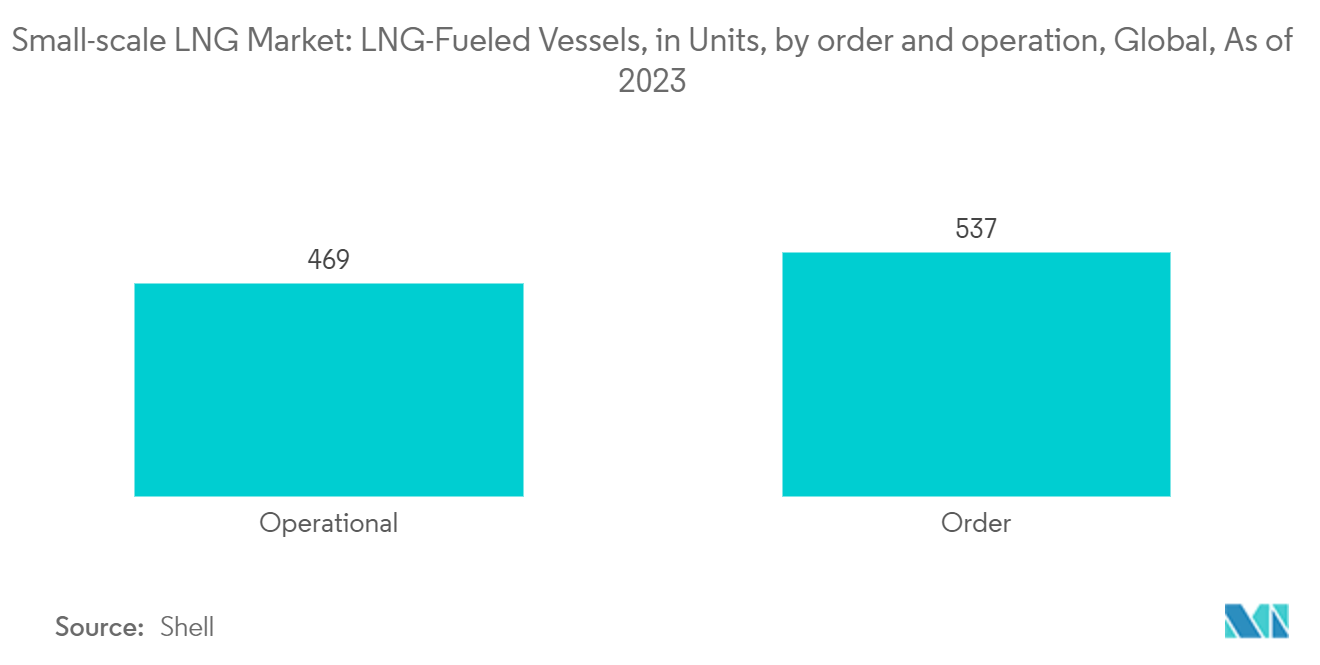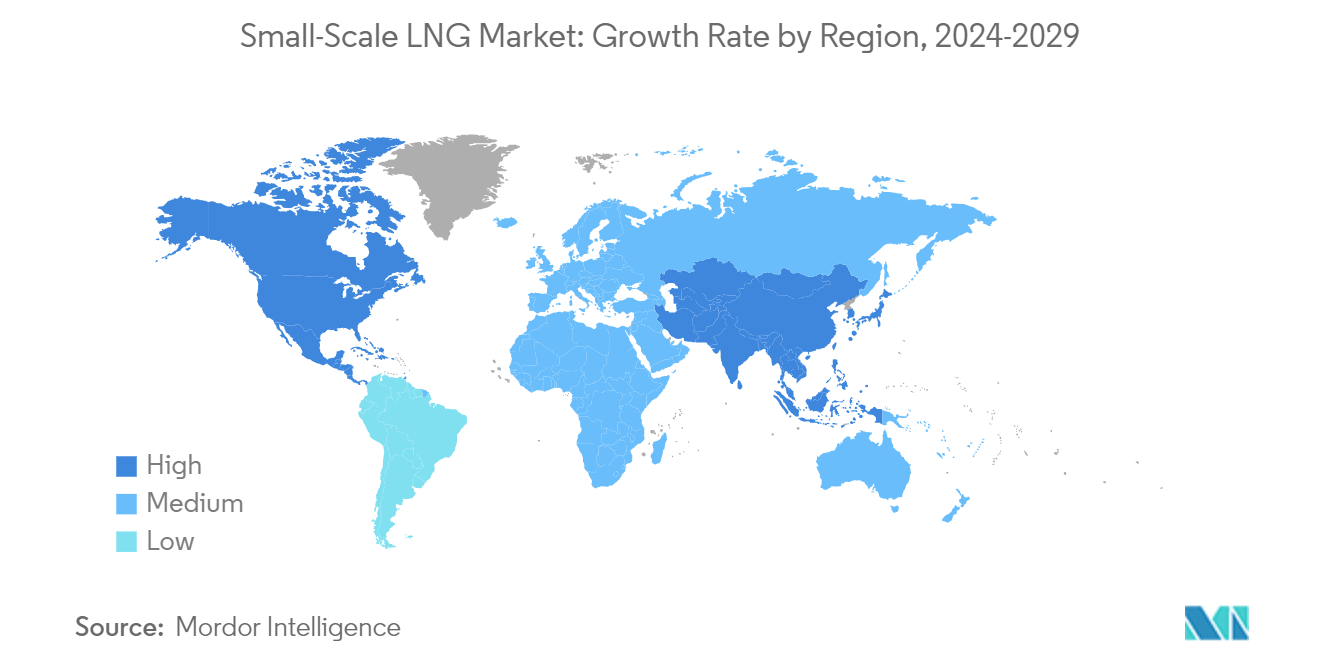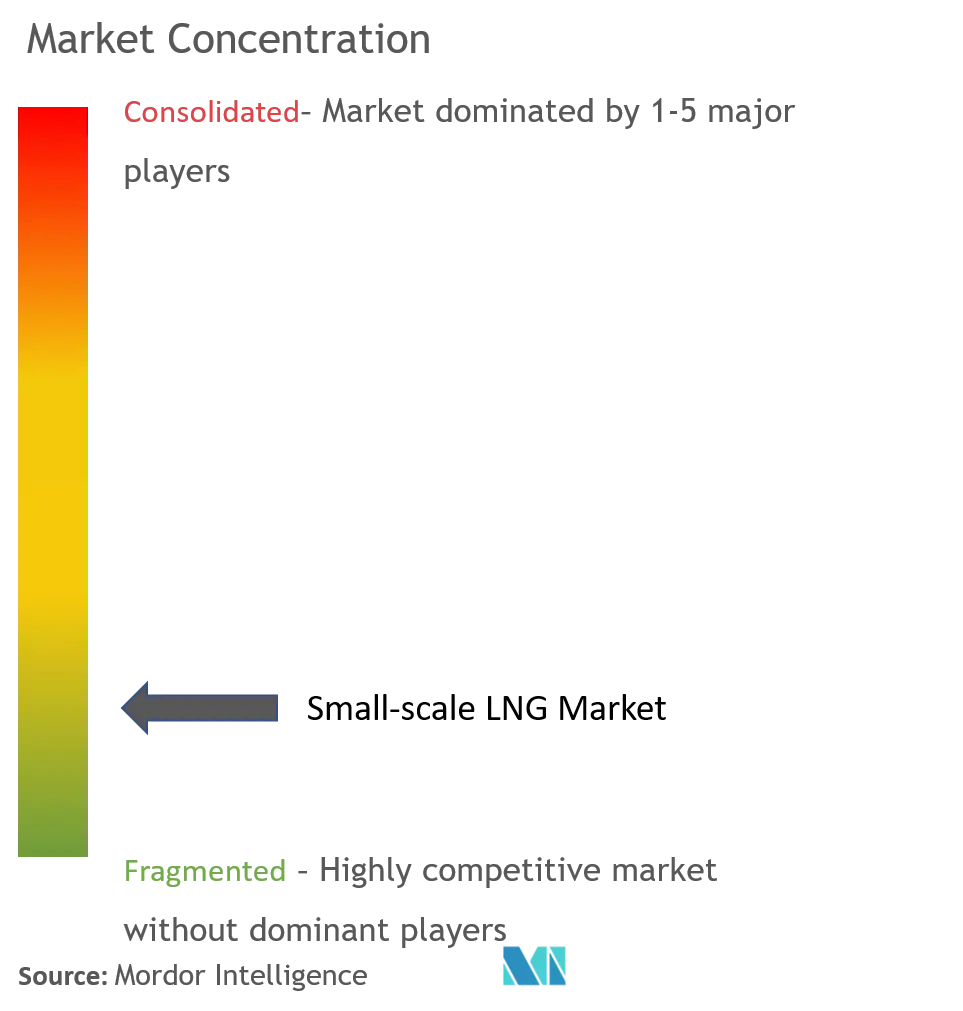Small Scale LNG Market Size

| Study Period | 2019 - 2029 |
| Market Size (2024) | USD 10.70 Billion |
| Market Size (2029) | USD 17.53 Billion |
| CAGR (2024 - 2029) | 10.38 % |
| Fastest Growing Market | North America |
| Largest Market | Asia-Pacific |
Major Players
*Disclaimer: Major Players sorted in no particular order |
Small-scale LNG Market Analysis
The Small-scale LNG Market size is estimated at USD 10.70 billion in 2024, and is expected to reach USD 17.53 billion by 2029, growing at a CAGR of 10.38% during the forecast period (2024-2029).
- Over the long term, factors such as increasing demand for LNG in bunkering, road transportation, and off-grid power will drive the small-scale LNG market in the coming years.
- On the other hand, factors such as the high operation cost of small-scale LNG, lack of supporting infrastructure in regions such as the Middle East and Africa, and high CAPEX requirements, along with a long payback period of more than 12 years, are expected to hinder the growth of the market.
- However, owing to the high capital expenditure required for a small-scale LNG infrastructure, developing cost-efficient small-scale LNG infrastructure is expected to provide significant opportunities to small-scale LNG technology providers and transporters.
- The Asia-Pacific region dominates the market and will likely witness a significant CAGR during the forecast period.
Small-scale LNG Market Trends
The Transportation Segment Expected to Dominate the Market
- LNG is primarily used to fuel trucks and ships, mainly due to its economic and environmental benefits, compared to diesel and fuel oil. Since LNG is non-corrosive and non-toxic, it can extend the life of a vehicle by up to three times. Moreover, since LNG has an extremely low boiling point, very little heat is required to convert it into a gaseous form at high pressure, with negligible mechanical energy. This makes LNG an efficient fuel for transportation.
- Handling LNG is an immense task since even a slight difference in the temperature can lead to the boiling and vaporization of fuel, which, in turn, leads to fuel wastage. Therefore, it makes passenger cars far less viable than heavy vehicles, such as commercial trucks. This has limited the application of LNG in the transportation segment.
- The use of LNG as a transportation fuel is gaining momentum across the world. China, the United States, and Europe have already started deploying LNG-powered trucks, mainly for long-distance freight carriage. This is mainly due to the government policies and regulations on decarbonizing and emission control, such as China VI and the European Green Deal.
- Formed in 2019 by the European Commission, the European Green Deal is a set of policy initiatives to make Europe carbon-neutral by 2050. The policies briefly underline the importance of LNG in reaching the aim, and they emphasize the usage of LNG as fuel for trucks and marine vessels.
- According to Shell LNG Outlook 2024, as of 2023, there were 469 LNG-fueled vessels in operation, and 537 LNG-fueled vessels were on order. The rapidly growing order book for LNG-fuelled vessels has witnessed rapid growth compared to previous years, and increasing numbers of ship owners and operators understand LNG's environmental and climate benefits.
- New emerging economies are also planning to lay the foundation for the future of LNG for transportation. For instance, in March 2024, Venture Global LNG started the construction of a new large fleet of LNG-powered vessels. The fleet includes nine vessels (Six vessels having a cargo capacity of 174,000 m3 and three with a cargo capacity of 200,000 m3) currently under construction in South Korea.
- Hence, owing to the above-mentioned factors, the demand for small-scale LNG infrastructure for the transportation segment will likely grow and significantly dominate the market during the forecast period.

Asia-Pacific to Dominate the Market
- In recent years, Asia-Pacific has been a pioneer in implementing small-scale LNG projects globally. Interest in using small-scale LNG (SSLNG) has increased in recent years as the demand for natural gas increases in countries like China, India, Singapore, and Japan.
- China is one of the world's major countries, which led to the growth in LNG demand. LNG imports totaled around 64.4 million tons in 2022. Due to this surge in demand, China became one of the world's largest LNG importers. The increased demand is due to Chinese LNG buyers signing long-term contracts for more than 20 million tons annually.
- China's natural gas market includes domestic production and import via pipelines and LNG terminals. In China, the rising demand for small-scale LNG is from the industrial, residential, and power generation sectors, with the highest potential being in the transportation sector. Growth in the number of LNG trucks due to the higher price of diesel, compared to natural gas, is expected to be the prime reason small LNG facilities are growing in China.
- In India, small-scale LNG is in a very nascent stage. However, there are a few LNG stations where LNG transportation through LNG trucks is taking place. To increase the share of natural gas to 15% in its energy mix by 2030, India will likely construct small-scale LNG facilities for natural gas supply to remote places with no pipeline infrastructure. For instance, in June 2022, GAIL Limited, a government-owned natural gas explorer and producer company, aimed to set up small liquefaction facilities for areas not connected to LNG pipelines.
- In March 2024, the Union Minister of Petroleum and Natural Gas of India launched the country's first small-scale LNG unit set up by GAIL at Vijaipur in Madhya Pradesh.
- The LNG bunkering facilities in the ports of Singapore majorly drive small-scale LNG business in Singapore. Singapore has one of the leading trade ports and is one of the global leaders in international marine shipping.
- Therefore, owing to the above points, Asia-Pacific is expected to dominate the growth of the small-scale market during the forecast period.

Small-scale LNG Industry Overview
The small-scale LNG market is semi-fragmented. Some of the major players in the market (in no particular order) include Linde PLC, Wartsila Oyj ABP, Shell PLC, Engie SA, and PJSC Gazprom.
Small Scale LNG Market Leaders
-
Shell PLC
-
Linde plc
-
PJSC Gazprom
-
Engie SA
-
Wartsila Oyj ABP
*Disclaimer: Major Players sorted in no particular order

Small-scale LNG Market News
- April 2024: the Indian Gas Exchange announced the contracts for small-scale liquefied natural gas on its platform after receiving approval from the Petroleum and Natural Gas Regulatory Board.
- November 2023: Elengy, a unit of Engie’s GRTgaz, established a new small-scale LNG carrier loading service at its Fos Tonkin terminal on France’s Mediterranean coast.
- May 2023: The National Gas Company of Trinidad and Tobago Limited signed a MoU with Globus Energy Group Trinidad Limited, Corban Energy Group, and Chester LNG LLC to identify and screen technologies for micro- and small-scale LNG development projects in the Caribbean.
Small Scale LNG Market Report - Table of Contents
1. INTRODUCTION
- 1.1 Scope of the Study
- 1.2 Market Definition
- 1.3 Study Assumptions
2. EXECUTIVE SUMMARY
3. RESEARCH METHODOLOGY
4. MARKET OVERVIEW
- 4.1 Introduction
- 4.2 Market Size and Demand Forecast in USD, till 2029
- 4.3 Recent Trends and Developments
- 4.4 Government Policies and Regulations
-
4.5 Market Dynamics
- 4.5.1 Drivers
- 4.5.1.1 Increasing Investment in LNG Infrastructure
- 4.5.1.2 Rising Demand for LNG in Bunkering, Road Transportation, and Off-grid Power
- 4.5.2 Restraints
- 4.5.2.1 Lack of Supporting Infrastructure in the Regions such as the Middle East and Africa
- 4.6 Supply Chain Analysis
-
4.7 Porter's Five Forces Analysis
- 4.7.1 Bargaining Power of Suppliers
- 4.7.2 Bargaining Power of Consumers
- 4.7.3 Threat of New Entrants
- 4.7.4 Threat of Substitutes Products and Services
- 4.7.5 Intensity of Competitive Rivalry
5. MARKET SEGMENTATION
-
5.1 Type
- 5.1.1 Liquefaction Terminal
- 5.1.2 Regasification Terminal
-
5.2 Mode of Supply
- 5.2.1 Truck
- 5.2.2 Transshipment and Bunkering
- 5.2.3 Pipeline and Rail
-
5.3 Application
- 5.3.1 Transportation
- 5.3.2 Industrial Feedstock
- 5.3.3 Power Generation
- 5.3.4 Other Applications
-
5.4 Geography (Regional Market Analysis {Market Size and Demand Forecast till 2028 (for regions only)})
- 5.4.1 North America
- 5.4.1.1 United States
- 5.4.1.2 Canada
- 5.4.1.3 Rest of North America
- 5.4.2 Europe
- 5.4.2.1 Germany
- 5.4.2.2 France
- 5.4.2.3 United Kingdom
- 5.4.2.4 Russia
- 5.4.2.5 Spain
- 5.4.2.6 NORDIC
- 5.4.2.7 Italy
- 5.4.2.8 Turkey
- 5.4.2.9 Rest of the Europe
- 5.4.3 Asia-Pacific
- 5.4.3.1 China
- 5.4.3.2 India
- 5.4.3.3 Japan
- 5.4.3.4 South Korea
- 5.4.3.5 Vietnam
- 5.4.3.6 Malaysia
- 5.4.3.7 Indonesia
- 5.4.3.8 Australia
- 5.4.3.9 Rest of the Asia-Pacific
- 5.4.4 South America
- 5.4.4.1 Brazil
- 5.4.4.2 Argentina
- 5.4.4.3 Colombia
- 5.4.4.4 Rest of South America
- 5.4.5 Middle East and Africa
- 5.4.5.1 Saudi Arabia
- 5.4.5.2 United Arab Emirates
- 5.4.5.3 South Africa
- 5.4.5.4 Egypt
- 5.4.5.5 Qatar
- 5.4.5.6 Nigeria
- 5.4.5.7 Rest of the Middle East and Africa
6. COMPETITIVE LANDSCAPE
- 6.1 Mergers and Acquisitions, Joint Ventures, Collaborations, and Agreements
- 6.2 Strategies Adopted by Leading Players
-
6.3 Company Profiles
- 6.3.1 Small-scale LNG Technology Providers
- 6.3.1.1 Linde PLC
- 6.3.1.2 Wartsila Oyj ABP
- 6.3.1.3 Baker Hughes Company
- 6.3.1.4 Honeywell UoP
- 6.3.1.5 Chart Industries Inc.
- 6.3.1.6 Black & Veatch Holding Company
- 6.3.2 Small-scale LNG Marine Transporter
- 6.3.2.1 Anthony Veder Group NV
- 6.3.2.2 Engie SA
- 6.3.2.3 Evergas AS
- 6.3.3 Small-scale LNG Operators
- 6.3.3.1 Shell PLC
- 6.3.3.2 Eni SpA
- 6.3.3.3 PJSC Gazprom
- 6.3.3.4 TotalEnergies SE
- 6.3.3.5 Gasum Oy
- 6.3.4 Market Ranking/Share (%) Analysis
- *List Not Exhaustive
7. MARKET OPPORTUNITIES AND FUTURE TRENDS
- 7.1 The Development of Cost-efficient Small-scale LNG Infrastructure
Small-scale LNG Industry Segmentation
Small-scale LNG (SSLNG) is defined as the liquefaction, regasification, and import terminals at plants with a capacity of less than 1 MTPA, according to the International Gas Union (IGU), and with applications in power generation, transportation, industrial feedstock, and other applications. SSLNG carriers are vessels with an LNG storage capacity of less than 30,000 cubic meters (m³) for transportation. The typical range of SSLNG storage capacity is between 500 m³ and 5,000 m³. Other elements of SSLNG include LNG bunkering facilities for LNG-fueled vessels, LNG satellite stations, and infrastructure to supply LNG as fuel for road vehicles.
The small-scale LNG market is segmented by type, mode of supply, application, and geography. By type, the market is segmented into liquefaction terminals and regasification terminals. By mode of supply, the market is segmented into truck, transshipment and bunkering, and pipeline and rail. By application, the market is segmented into transportation, industrial feedstock, power generation, and other applications. The report also covers the market size and forecasts for the small-scale LNG market across major regions. For each segment, the market sizing and forecasts were made based on revenue (USD).
| Type | Liquefaction Terminal | |
| Regasification Terminal | ||
| Mode of Supply | Truck | |
| Transshipment and Bunkering | ||
| Pipeline and Rail | ||
| Application | Transportation | |
| Industrial Feedstock | ||
| Power Generation | ||
| Other Applications | ||
| Geography (Regional Market Analysis {Market Size and Demand Forecast till 2028 (for regions only)}) | North America | United States |
| Canada | ||
| Rest of North America | ||
| Geography (Regional Market Analysis {Market Size and Demand Forecast till 2028 (for regions only)}) | Europe | Germany |
| France | ||
| United Kingdom | ||
| Russia | ||
| Spain | ||
| NORDIC | ||
| Italy | ||
| Turkey | ||
| Rest of the Europe | ||
| Geography (Regional Market Analysis {Market Size and Demand Forecast till 2028 (for regions only)}) | Asia-Pacific | China |
| India | ||
| Japan | ||
| South Korea | ||
| Vietnam | ||
| Malaysia | ||
| Indonesia | ||
| Australia | ||
| Rest of the Asia-Pacific | ||
| Geography (Regional Market Analysis {Market Size and Demand Forecast till 2028 (for regions only)}) | South America | Brazil |
| Argentina | ||
| Colombia | ||
| Rest of South America | ||
| Geography (Regional Market Analysis {Market Size and Demand Forecast till 2028 (for regions only)}) | Middle East and Africa | Saudi Arabia |
| United Arab Emirates | ||
| South Africa | ||
| Egypt | ||
| Qatar | ||
| Nigeria | ||
| Rest of the Middle East and Africa |
Small Scale LNG Market Research FAQs
How big is the Small-scale LNG Market?
The Small-scale LNG Market size is expected to reach USD 10.70 billion in 2024 and grow at a CAGR of 10.38% to reach USD 17.53 billion by 2029.
What is the current Small-scale LNG Market size?
In 2024, the Small-scale LNG Market size is expected to reach USD 10.70 billion.
Who are the key players in Small-scale LNG Market?
Shell PLC, Linde plc, PJSC Gazprom, Engie SA and Wartsila Oyj ABP are the major companies operating in the Small-scale LNG Market.
Which is the fastest growing region in Small-scale LNG Market?
North America is estimated to grow at the highest CAGR over the forecast period (2024-2029).
Which region has the biggest share in Small-scale LNG Market?
In 2024, the Asia-Pacific accounts for the largest market share in Small-scale LNG Market.
What years does this Small-scale LNG Market cover, and what was the market size in 2023?
In 2023, the Small-scale LNG Market size was estimated at USD 9.59 billion. The report covers the Small-scale LNG Market historical market size for years: 2019, 2020, 2021, 2022 and 2023. The report also forecasts the Small-scale LNG Market size for years: 2024, 2025, 2026, 2027, 2028 and 2029.
What are the key trends in the Small-Scale LNG Market?
The key trends in the Small-Scale LNG Market are a) Growth in LNG-fueled marine ships and carriers b) Increased development in LNG-fueled rails c) Transformation of diesel fuel-powered locomotives into LNG-powered locomotives d) Expansion of LNG-powered vehicles in various industries
What are the major challenges faced by the Small-Scale LNG Market?
The major challenges faced by the Small-Scale LNG Market are a) Smaller liquefaction capacities compared to large-scale plants b) Expenses associated with modifying existing infrastructure for small-scale LNG operations c) Vulnerability to adverse weather conditions and logistical challenges d) Relatively higher production costs compared to large-scale LNG
Small Scale LNG Industry Report
The small-scale LNG market is experiencing significant growth, driven by its diverse applications across transportation, industrial, residential, and marine sectors. Dominated by the transportation segment, the increasing adoption of LNG as a cleaner alternative fuel in heavy-duty vehicles and marine vessels is notable. Additionally, there's a rising trend in using LNG for off-grid power generation in remote areas. The Asia-Pacific region leads in market share, spurred by escalating energy demands and environmental concerns. Innovations in liquefaction and regasification technologies are advancing the market, making LNG a practical solution for areas without large-scale infrastructure. The integration of new technologies and strategic partnerships is enhancing the efficiency and accessibility of small-scale LNG, meeting the global demand for sustainable and flexible energy solutions. Small-scale LNG companies play a crucial role in these advancements, driving market expansion and the broader adoption of LNG solutions. For detailed statistics, market share, size, and revenue growth insights, consider accessing a comprehensive industry analysis from Mordor Intelligence™, which includes forecasts and a historical overview available as a free report PDF download.



